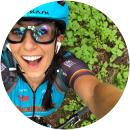The snowline is getting closer to town and the first official day of winter is only a couple weeks away! Just because winter is here doesn’t mean that you have to stop having fun with your bike on the trails, especially if you have a fatbike. If you’re not familiar with fatbikes, they are off-road bicycles designed with very wide tires, starting around 3.8 inches wide.
Why do you need a wider tire than a mountain bike? For riding on snow (and actually sand and mud), a wide tire helps you float over the terrain. With wider rims and tires, you can also run significantly less tire pressure which we’ll get to in a minute.
Whether you’re new to fatbiking or if you’re a well-seasoned rider, these fatbike tips will be useful to upping the fun factor.
Run low tire pressure: 5-6 PSI. The low pressure will enable your tires to have extra traction on the snow. If your tires are bouncing off of obstacles or if your tires are slipping, it could be that you have too much tire pressure.
Pedaling: Choose a slightly harder gear than usual. Lower your seat by about half an inch and try to stay seated while pedaling. All of these elements will help keep weight on your back tire and prevent it from slipping
Pedals: Clipless pedals with some winter boots can help with more power to the pedals. However, if you’re doing a lot of hiking, chances are the cleat will pack with snow and ice and no longer work. Consider flat pedals.
Braking: If conditions are slick, consider going light on the brakes. Try not to make any sudden stops or corrections (similar to driving!). You get more braking power from the front. If conditions are steep, consider staying off the rear brake so your back wheel doesn’t slide sideways but beware of losing your front wheel as well.
Clothing: You can get pogies or bar mitts for the handlebars which are like oversizes gloves that hook onto the handlebar that you can put your hands in if your hands are prone to getting cold. I also sometimes use big ski gloves and even a down jacket! Plan for changing conditions with an extra layer and avoid wearing cotton as a base layer. I like to use a Buff for my head and neck, a base layer, long sleeve jersey, and a jacket or vest if it’s really cold. Typically, colder conditions make for better fatbiking conditions. Slush and the freeze/thaw cycle can make the trail dangerous so beware!
Different types of trail conditions will affect how you ride. Packed trails are the most fun and the easiest to ride. Fresh powder is a big challenge because you’ll be packing it down as you ride and even sinking if it is deep. On powder days, be prepared to hike your bike up and to have a major balancing act on the way down. The good news is that it usually doesn’t hurt when you fall. Ice and crust can be tricky. No sudden movements! In general, try not to fight your bike and try to go with the flow of where it is tracking.
The Okanagan has some great groomed options at some of the ski areas. Myra-Bellevue tends to have the most packed down trails from snowshoers and hikers, and easy access from the parking lot. ‘Tis the season for winter adventures! Have fun and see you on the trail!








